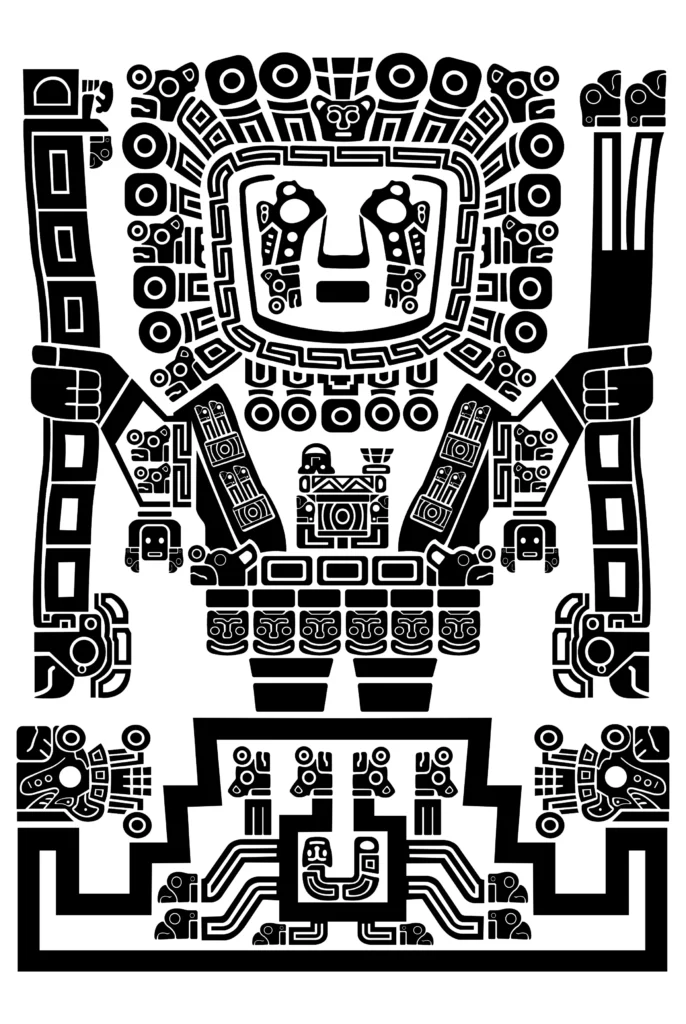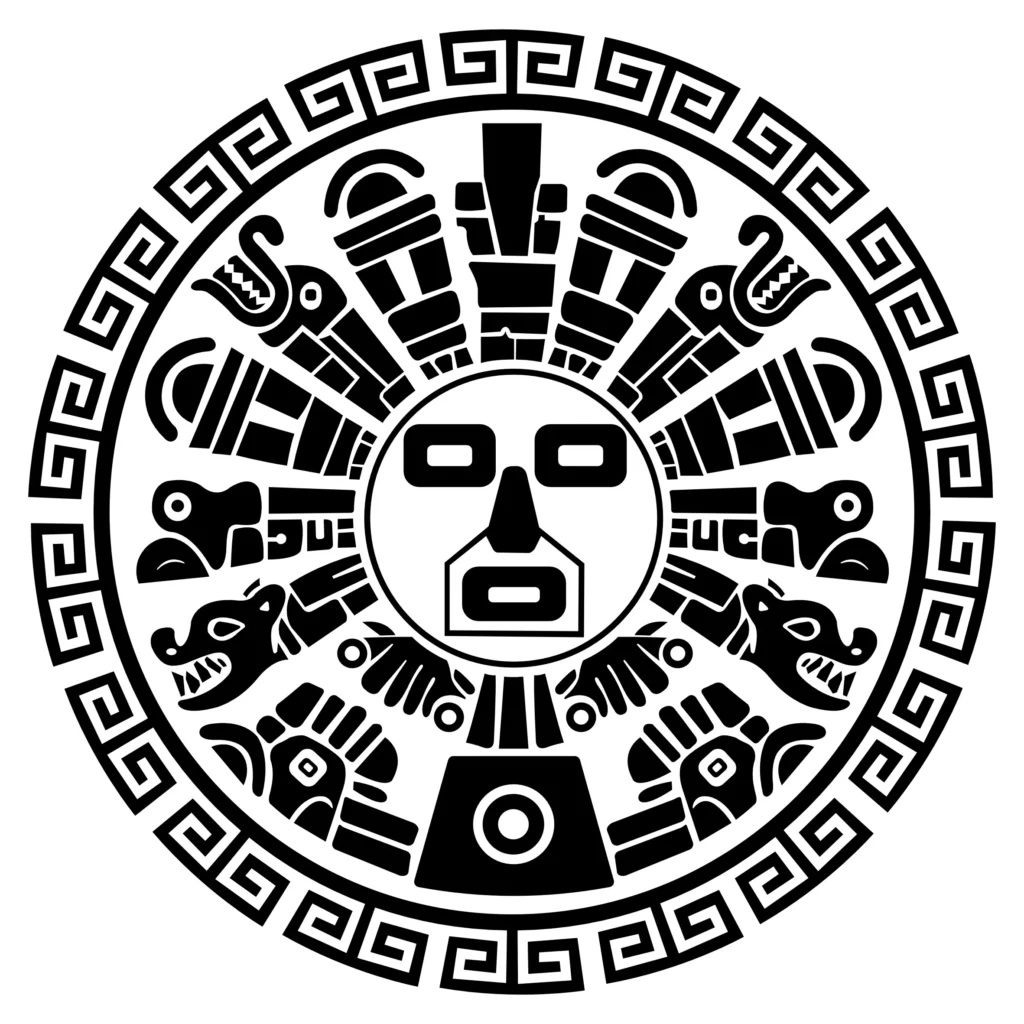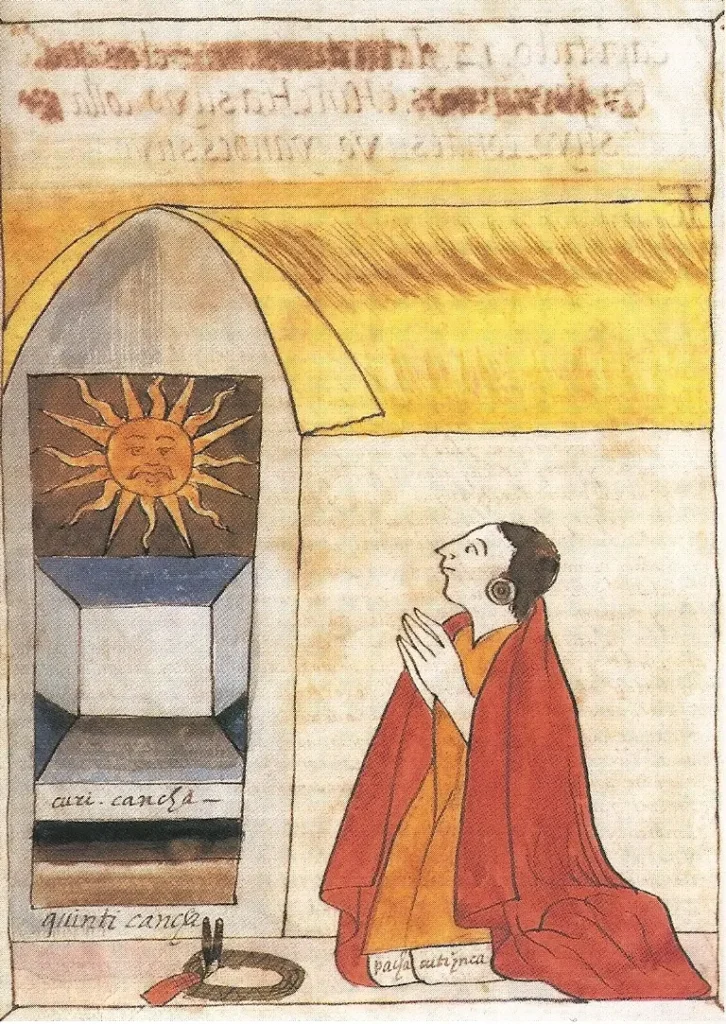The Inca gods constitute a fundamental part of the worldview of the Inca empire, a civilization that flourished in the Peruvian Andes. These gods were worshiped and revered by the Incas, who believed in their power to influence all aspects of life, from climate to agriculture to warfare. Here is a brief description of the most important Inca gods:
Viracocha is considered the supreme creator and the main god of the Inca pantheon. According to mythology, it was he who shaped the universe, created the first human beings and established the cosmic order. He is represented as a bearded man, dressed in a tunic and holding a staff and a scepter. Likewise, temples and sanctuaries were built in his honor, offering him offerings and sacrifices to protect his people.

Inti was the sun god and one of the most important deities in the Inca religion. He was considered the father of all Incas and was attributed with fertility, prosperity and success in war. The Incas performed sacrifices in his honor and built impressive temples, such as the famous Temple of the Sun in the city of Cusco. He was represented as a radiant man with red and yellow sun rays.

Pachamama is one of the most revered divinities in Andean culture, representing Mother Earth. The Incas believed that she was responsible for providing fertility to the land and protecting its inhabitants. She was worshipped through ceremonies and rituals involving offerings of food and animals, fruits.
Mama Killa was the goddess of the moon and an important figure in Inca mythology. She was believed to have the power to influence lunar cycles and crop fertility. The Incas performed ceremonies in her honor, especially during lunar eclipses, to ensure her favor and protection. Mama Killa was represented as a beautiful woman associated with fertility and femininity. She had a temple located in the city of Cusco.
Illapa was the god of lightning, thunder and storms, and was considered a powerful and fearsome deity. He was believed to control the weather and was capable of bringing beneficial rains or destructive storms. The Incas offered him sacrifices to appease his wrath and ensure a successful growing season. He was depicted armed with lightning bolts and a golden mace, ready to unleash his power on the earth.
In the Inca worldview, the minor gods and regional deities played fundamental roles in daily life and in the spiritual structure of the empire. Unlike the main gods such as Inti (the sun god) and Viracocha (the creator), the minor gods and regional deities were more linked to specific aspects of nature and to particular geographic regions.
The Apus were considered the sacred mountains and, in turn, the protective guardians of these high lands. In Inca mythology, it was believed that each mountain had its own associated deity, which was revered and respected by the communities living nearby. The Apus were revered for their power to control the climate, provide water and fertility to farmlands, as well as for their ability to protect the inhabitants from natural dangers and invaders.
The Incas performed ceremonies and rituals in honor of the Apus, offering them sacrifices of food, animals and other offerings as a sign of respect and gratitude for their protection and benevolence. These mountains were not only considered as divine entities, but also as mediators between the earthly world and the spiritual world, serving as points of connection with the higher gods.
Mama Cocha was the goddess of the sea and waters, a figure revered for her vital role in the life and livelihood of coastal communities and fishermen. In Inca mythology, she was represented as a maternal figure who provided both food and protection through the waters she controlled. Mama Cocha was believed to be responsible for maintaining balance in marine ecosystems and ensuring the fertility of the waters for fishing and agriculture.
The Incas performed ceremonies and rituals in honor of Mama Cocha, offering her sacrifices of products and other offerings to ensure her favor and protection. In addition, she was also believed to have influence over the maritime climate and weather conditions, which made her a fundamental figure for the well-being of coastal communities.
Supay was the lord of the underworld in Inca mythology, a figure feared and respected for his power over the spirits of the dead and for his ability to punish those who did not fulfill their duties in life. He was associated with darkness, death and the realm of the dead, and was believed to dwell in the depths of the earth, in a place known as Uku Pacha.
Although Supay was feared, he was also revered and rituals and ceremonies were performed to appease his wrath and ensure the welfare of the deceased in the afterlife. He was believed to have the power to influence the lives of the living, both in terms of illness and misfortune as well as prosperity and fortune.
The history of the Inca gods goes back to the myths and legends of the ancient civilization that developed in the Andes of Peru and other regions of South America. According to Inca mythology, the creator god Viracocha emerged from Lake Titicaca and created the world and mankind with the help of his partner, Mama Cocha, and his son Inti, the sun god. These three main gods formed the divine triad that ruled over the universe and nature.
Over time, the minor gods and regional deities were integrated into the Inca religion, each with their own domains and responsibilities. The Incas worshipped their gods through religious ceremonies, sacrificial rituals and festivals dedicated to honoring their power and influence over daily life.
The arrival of the Spanish conquistadors at the end of the 15th century caused a significant change in Inca religion, as the Europeans imposed Christianity and suppressed many of the indigenous religious practices. Despite this, some aspects of Inca mythology have endured in Peruvian culture and tradition, keeping alive the memory of the ancient gods and their legacy in the region.

Inca mythology is rich in deities and beliefs that have fascinated people all over the world. Here, we answer some frequently asked questions to provide a deeper understanding of the Inca gods:
The most relevant god in the Inca religion was Viracocha, considered the supreme creator, Viracocha was venerated as the architect of the universe and the source of all life. He was attributed with the creation of the world, humanity and the introduction of civilization. His influence transcended all other deities, and he was associated with water, the mountains and the sky.
The Inca gods influenced all aspects of people's daily lives. For example, farmers offered sacrifices to Pachamama to ensure good harvests, warriors honored Inti before going into battle for protection, and priests performed rituals in honor of the deities to maintain cosmic balance. Inca religion was deeply and significantly embedded in daily life.
Yes, there are parallels between Inca gods and other mythologies, especially those of other Mesoamerican cultures. For example, Viracocha shares similarities with Quetzalcoatl, a principal deity in Aztec mythology, both of which are considered creator gods. In addition, representations of nature and the relationship between the gods and the elements are common themes in many mythologies of the world.
The Incas attributed great spiritual significance to various animals that they considered sacred. For example, the condor was seen as a messenger between the gods and humans (Hanan pacha or the world above), the puma symbolized strength, wisdom and power (Kay pacha or the world now), and the snake also represented wisdom and renewal (Ukhu pacha or the world of the muetes). These animals were not only worshipped, but were also an integral part of religious ceremonies and rituals.
The arrival of the Spanish conquistadors had a devastating impact on Inca religion. The Spaniards imposed Christianity and prohibited Inca religious practices, destroying temples and repressing priests. Many of the Inca gods were demonized or reverted to the new Catholic religion. This event marked the decline and transformation of the Inca religion.
In modern culture, there has been a resurgence of interest in Inca mythology and religion, as people seek to reconnect with their roots and explore new forms of spirituality, the Inca gods have gained relevance in contemporary literature, art and music. In addition, tourism in places such as Machu Picchu, Ollantaytambo, Pisac has contributed to keep alive the memory of the ancient Inca gods.


